Running multiple WordPress websites can be tough. That’s why lots of people want to cut their maintenance down and run multiple WordPress blogs on one WordPress install. You would only update plugins once, not six times. Security would be tighter. Users only need a single login. There are lots of benefits to consolidating things into one WP site. Unfortunately, you can’t do it.
That’s Right…You Can’t Have Multiple Blogs
At least, not by default. The way that the WordPress Core is set up, each installation is an individual site. It has one database with one set of users tied to it. The Posts and Pages are all attributed to the single URL, database ID, and RSS feed. One site, one stream of Posts.
Everything about the system is designed for simplicity and ease of use. That’s why they have that famous 5-minute install. If you need a second or third blog, you just spin one up.
But that’s not very efficient. It doubles, triples, and exponentially increases the maintenance and security that you have to worry about. Not to mention URLs and domain authority and forwarding and…
You get it. Having multiple blogs on multiple sites just isn’t what you want. Even though that’s technically the WordPress way of doing things. When you look at Settings – Reading, you can only choose 1 page to be the home for your Posts, which will display them all as a feed.
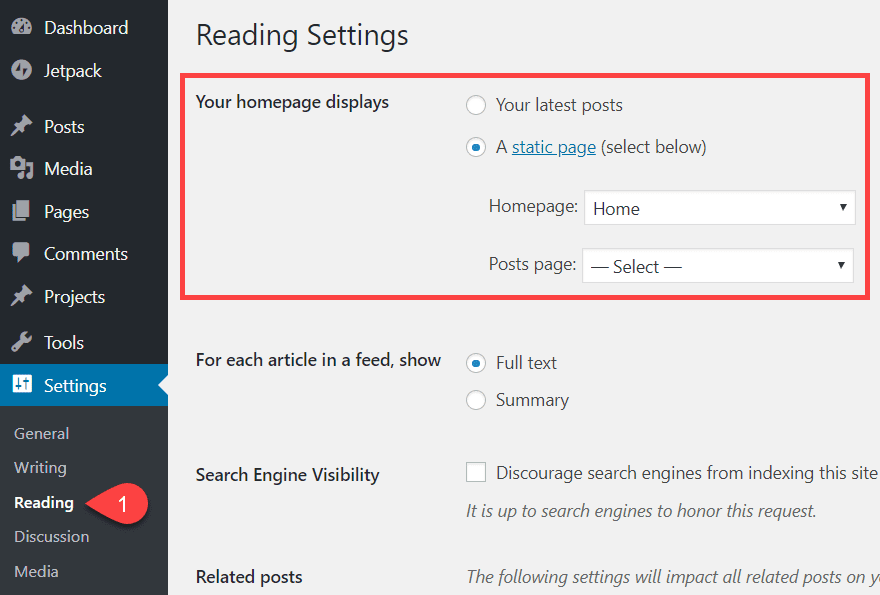
However, there’s hope. We are going to offer two solutions for how you can have multiple WordPress blogs on one WordPress install.
- Use custom categories and menus to filter and display Posts
- Create a WordPress Multisite install with multiple blogs on a WPMU network
Both of these ways are built into WordPress itself. They’re pretty simple to set up and use (for the most part). We are not using plugins to do this. However, even though they are built i, these methods aren’t just clicking a button that says Create New Blog. (After installing Multisite, will be, though!) With that in mind, let’s push forward and see what we can do to run multiple blogs rather than what we can’t.
Probably the easiest way to create multiple blogs on one site is to make use of Categories, Menus, and Users features already built into WordPress.
The first thing to do is log into your site and navigate to Posts – Categories. It will be near the top of the left sidebar in the admin panel.
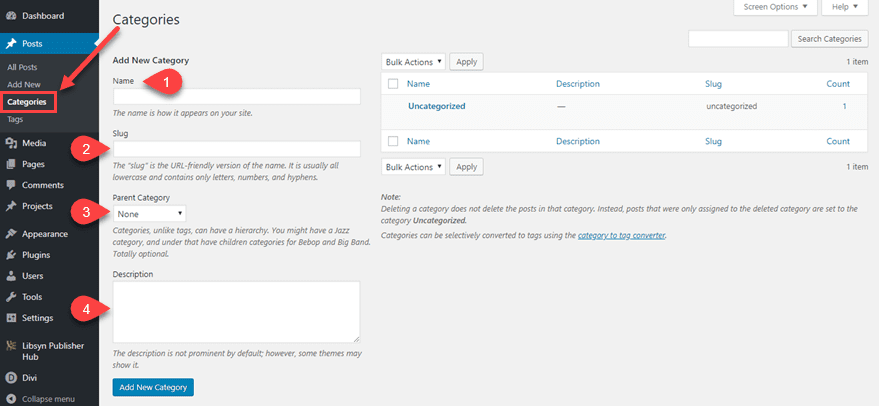
You will see four fields for your Categories on this screen. Each of them is important to properly set up your WordPress site to host multiple blogs.
- Name – This one will be the displayed title of the blog. If you have Categories indexed by search engines, the archive will bear this title. If not, this name will be for internal use only, though it might display in some themes.
- Slug – Like a Post slug, the Slug for a Category indicates where you can find the category archive. Depending on your permalink settings (under Settings – Permalinks), this could also be part of your post structure.
- Parent Category – The parent category is very important for running multiple blogs on one site. You might run a brand called The Umbrella Corporation that will have its own posts, and your blogs might be called Raccoon City, Leon’s Journal, and Claire’s Diary. Each of those would be separate but tied to the main brand. You can also do this for a parent category as a primary blog for a podcast, but use subcategories as season archives. This one is optional, depending on the structure you want.
- Description – The description might not show up everywhere (or anywhere) depending on your theme. But it can be indexed by search engines, and it is good for the internal organization if nothing else. Definitely worth putting a Tweet’s worth of info here.
Once completed, the new Categories will appear to the right of the page as a list. Each Parent Category will be listed above its respective children.
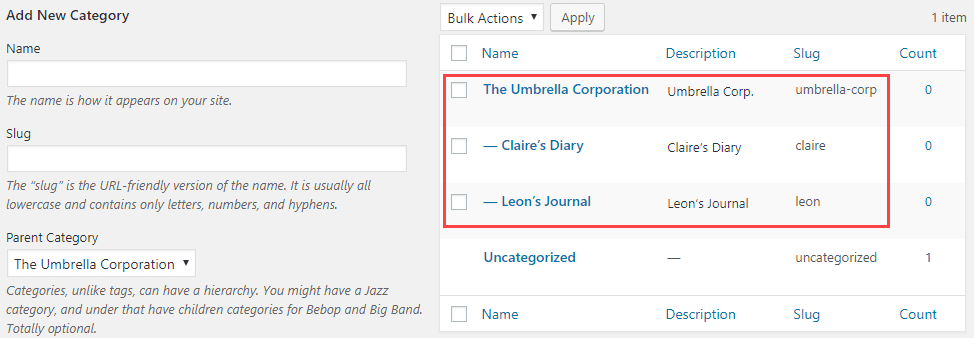
Additionally, whether you actually check the box or not, the Child is always going to be listed under the Category in archives and URL structures. So you might want to not use the Parent/Child hierarchy and set them all as top-level categories if they’re all autonomous.

By using Categories, you can now put direct links to the “blogs” in the navigation menu of your site. Navigate to Appearance – Menus and select which menu(s) you want to add the links to.
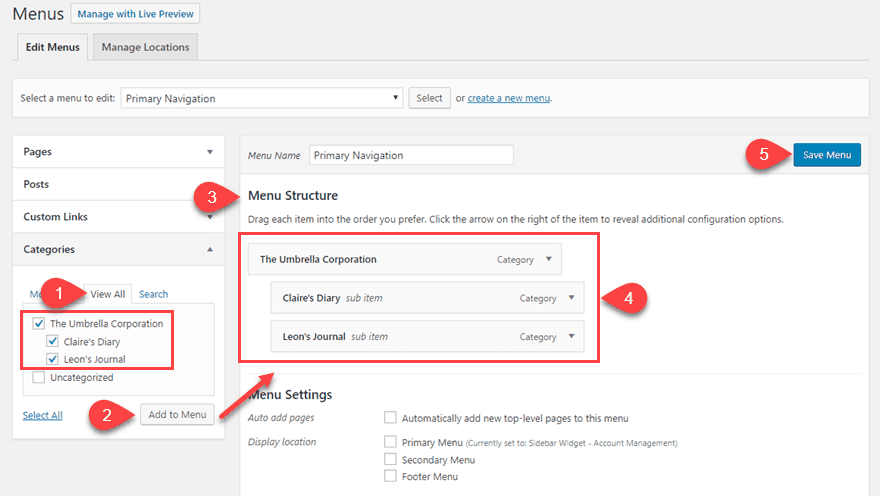
- Find the new Categories under the View All tab since you haven’t used them before.
- Select which ones you want to add to the menu and press the Add to Menu button.
- The Menu Structure will update to include the selections you made.
- Drag the individual blogs you want to be sub-items into place if desired. If they are not indented, they will be top-level items in the navigation.
- Press Save Menu. Menus do not save automatically in WordPress, and this is an incredibly easy step to miss.
With that saved, you will now be able to see the blogs listed separately in whatever menus you created.
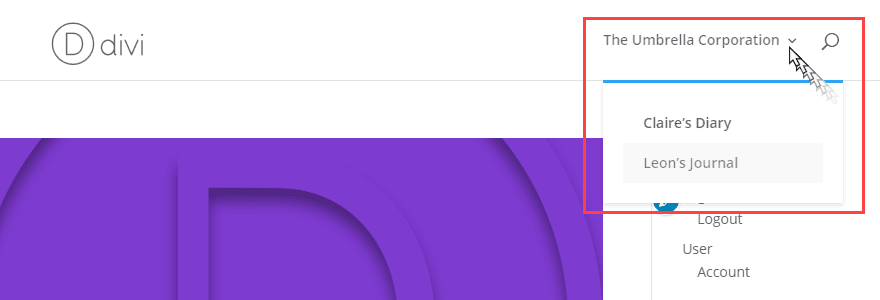
When you click on any one of these, you will be brought directly to that Category’s page (archive). It will be a feed of posts that you’ve included in those Categories. Just like the main feed of your blog.

The downside of doing this is that your primary blog URL is pretty ugly. You don’t want people to see that you’re using Categories as blogs. That may be embarrassing. But we can fix that. The URLs won’t be so ugly if you set the permalink structure to be something readable. And that is easy to do.
Changing Your Blog’s Permalink Structure
Navigate to Settings – Permalinks in your WP dashboard. You will have two options in there that we suggest changing. The first is your Post permalink. WordPress includes a lot of variables to choose from. Depending on your needs, you can customize it however you want. Our suggestion is the Category/Post Name (%category%/%postname%) structure for SEO. Just Post Name works, too.

With that done, your URL for each post will be exactly as it’s typed above. You only have one more step before being finished with setting up the new blog. You just need to change what WordPress uses for the Category permalink. So scroll down further in Settings – Permalinks until you see Category Base.

You can change that to whatever you want, but blog or blogs is a safe choice. This will let you have the example.com/blog/umbrella-corp structure as a URL for each blog, which is much better. Each child category will be added on. However, if you choose not to use the Parent/Child hierarchy, that’s not a factor.

Create a Home Page for Each Blog (Optional)
Each blog has its own Category now. The URLs and menus and archives are ready. You might want to set up a more customizable home page, though. Archives Pages are not always the most customizable pages in WordPress, so we want to show you how you can use a page builder plugin (like Divi) to create a unique home page for each blog.
I suggest making them using the same slug that you used for the category itself. This will not mess anything up, as the URL for the category will be example.com/category/slug, remember, and this Page will be example.com/slug. More than anything, this is for consistency’s sake than anything else.

When you are using a builder (we will be using Divi in this example), open the Page you have created for the blog in your editor. In Divi, you will select the row, then press the Black + Circle which brings up the Insert Module modal. From there, select Blog from the New Module tab.
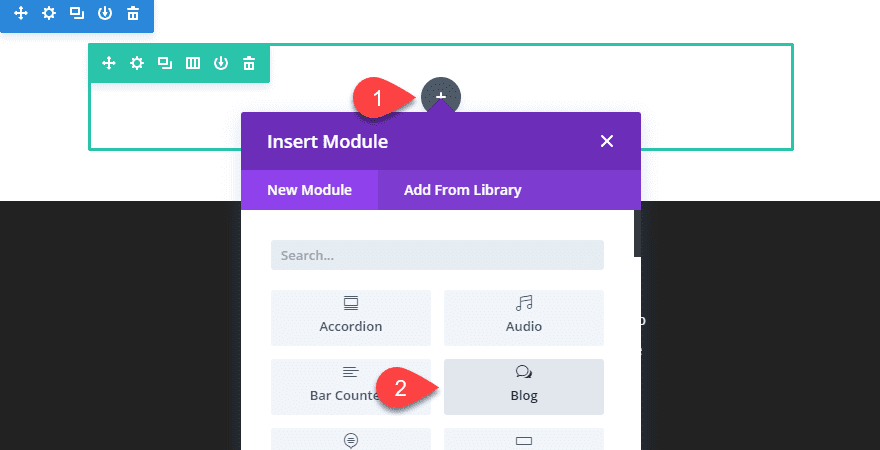
In the Blog Module settings, you will see a Content tab. Scroll until you see the Categories list.
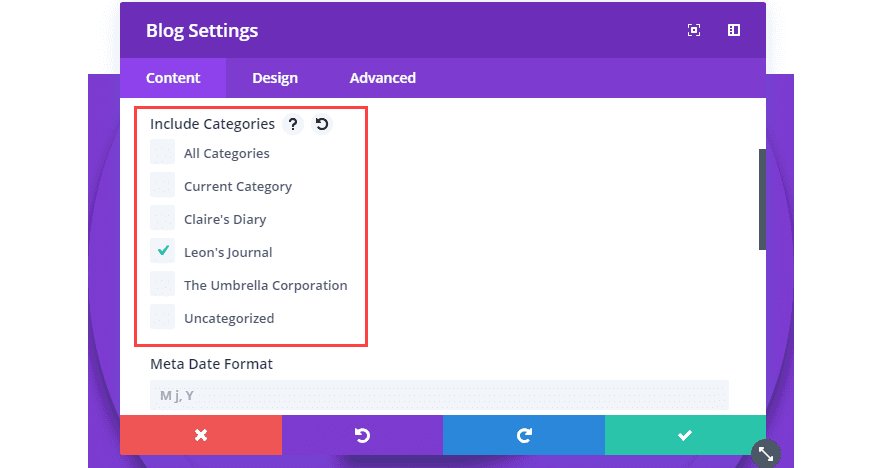
Select whichever Category you have used for the blog and press the Green Check Mark to save any changes you’ve made. There are plenty of other customization options you have access to in Divi and other builders, but that’s secondary to actually showing the posts for the blog, right? Now, the module should be displaying any Posts tagged with that Category. And only those tagged that way.
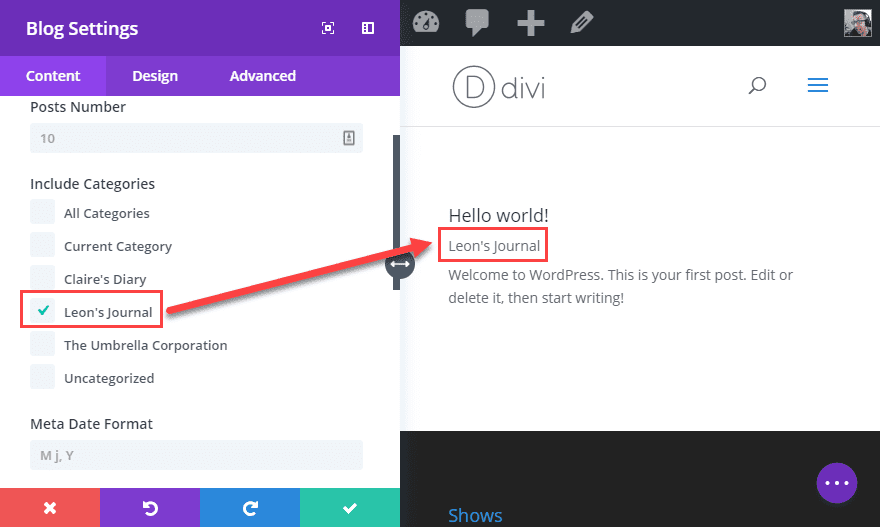
This works best for either Child categories only, or if you use solely top-level categories to run multiple WordPress blogs on one WordPress install. Because if you choose to display a Parent category this way, you will get every Post from all of its children, too. Even if they are only tagged with the child Category.
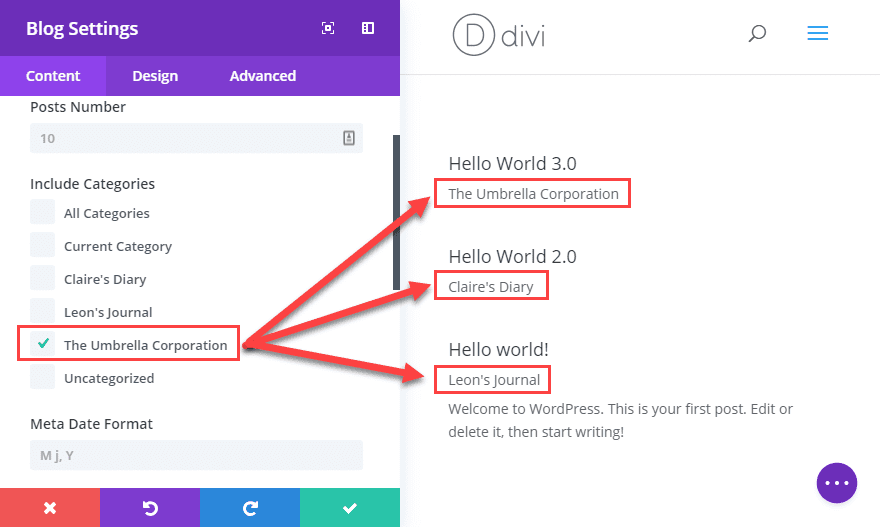
With that done, you can continue to customize the Page to suit the blog it hosts. Users who visit this page will only see a list of the Posts you’ve filtered through the Blog Module, and since the URL is to a Page directly, they’ll be none the wiser.
Congrats! You’ve just separated one WordPress blog into many without using anything but built-in tools!
Creating Individual Feeds for the New Blogs
If someone were to subscribe to your blog, the feed they would get would include each individual category. Because they’d be subscribing to the website’s feed. If you want to get a separate feed for each individual category on your site, it’s dead simple: add /feed to the end of the URL. That’s it. Super easy. Super simple. People can subscribe to the new blogs at something like this: example.com/blog/umbrella-corp/feed.

Option 2. Using WordPress Multisite for Multiple Blogs
In some ways, using WPMU is a more complete solution to the problem than using categories. Because what a multisite installation is, is technically one central hub with a network of WP sites branching off of it. Websites in a Multisite installation share themes and plugins (and a superadmin user), but maintain autonomy in most other ways. Additionally, when you use a Multisite install, the primary domain name is shared in some way, linking all of the sites on the network together.
We have an incredibly in-depth guide on how to set up a WordPress multisite installation already, so we won’t go into too much depth on that here.
The reason we suggest using Categories over WPMU is that multisites can get complicated fast. From installation to ensuring that they are compatible with each other, there are special issues that arise. However, if you want to convert your site into a multisite, here’s what you need to do.
Add WMPU Code to wp-config.php
You will want to find the wp-config.php file for your site in the home directory of your install. Then open it up and add the following lines to it, just above where it says /* That’s all, stop editing! Happy blogging. */
/* Multisite */ define( 'WP_ALLOW_MULTISITE', true );
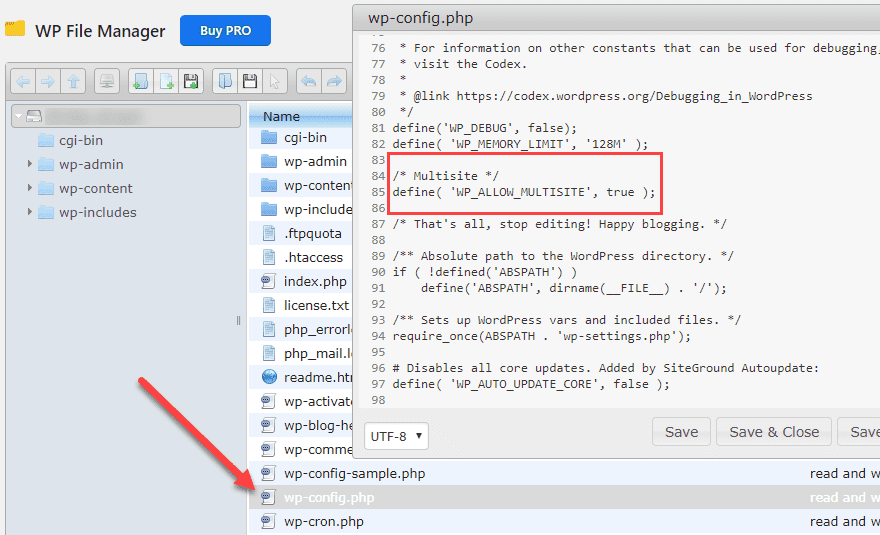
Save that, and you will have a new item in your WP admin menu under Tools – Network. Inside there, you will have a screen that lets you know what setting up a WPMU site entails.
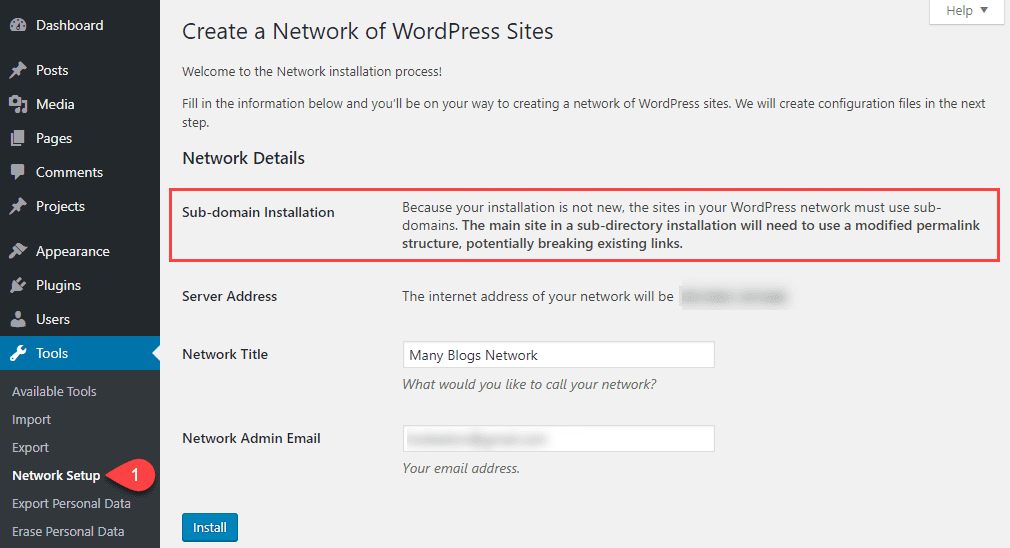
You get to name the network, and it tells you the primary domain it will be located. Also, you will only be able to use subdomains, not subdirectories. You can have blog.example.com, but not example.com/blog to prevent existing Posts/Pages from having conflicts. When you’re ready to proceed press Install.
The following screen provides the code you will have to paste into the wp-config.php and .htaccess files.
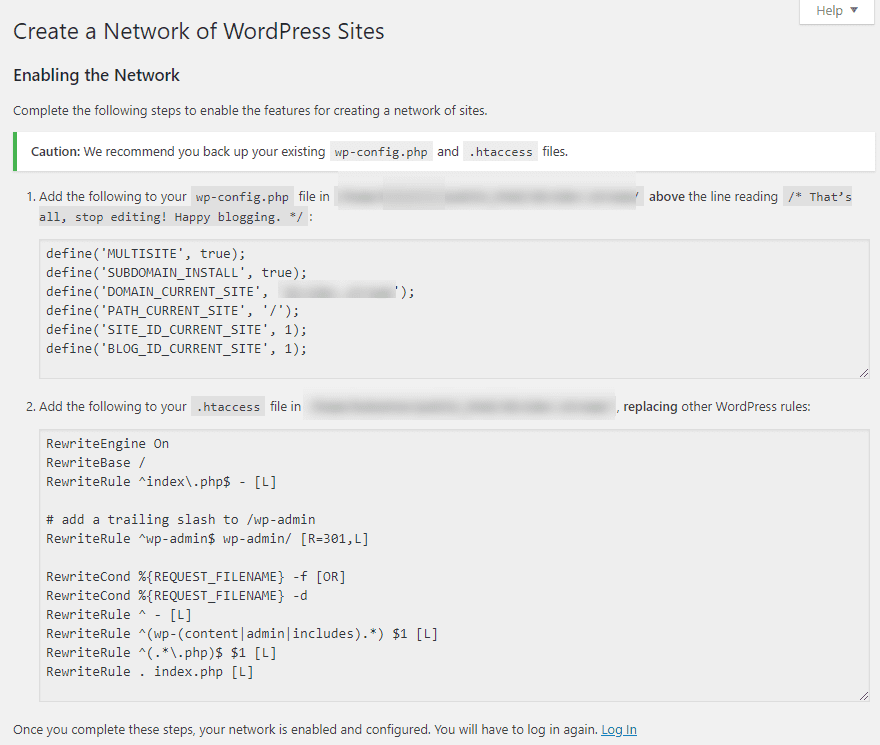
When that is done, and you’ve pasted them and refreshed/logged back in, you should see a couple of new features. In the upper-left of the screen, you’ll see a My Sites dropdown in the admin bar and a Sites section in the dashboard itself.
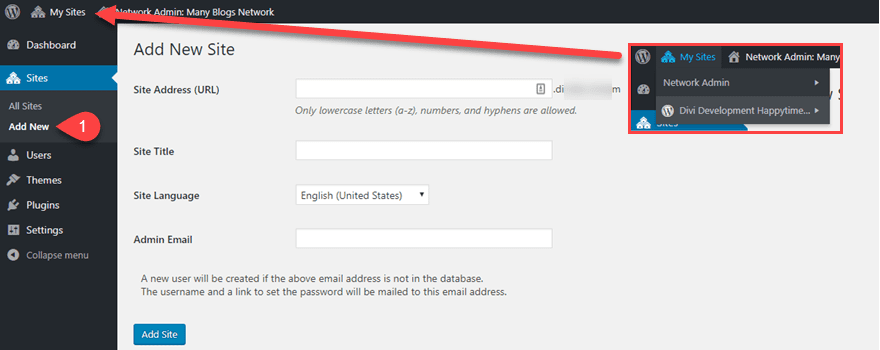
As you hover over the admin bar, a list of sites appears, with a menu of actions you can take with them. And under Sites, the Add New button lets you create new WP installations with a click of a button (and a few form fields). Immediately after clicking the Add Site button, you will see the new one listed as a part of your network.
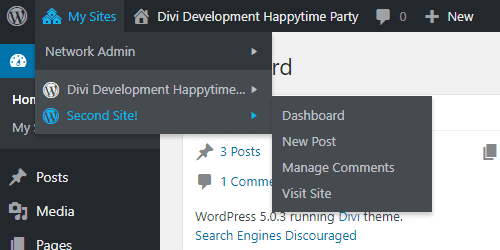
In most respects, the new sites you create for blogs will be like completely autonomous sites. They have their own feeds, URLs (based on the subdomain), and set of users. So to link them back to the main page, you will be doing the same thing you did with the menus before. Only this time, you use the Custom Link option.
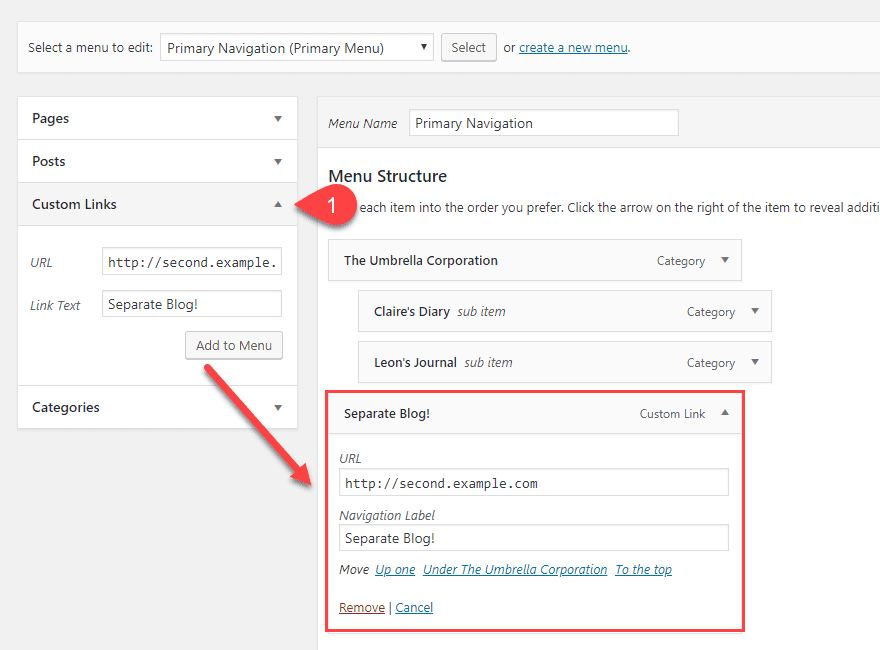
And that’s it! You still have to design and actually work on the other site. But you can use it immediately as a separate blog.
Note on Subdomain vs Subdirectories with Multisite
If you want to use subdirectories with WPMU, you have to do a clean installation from scratch. Otherwise, you will have to use subdirectories, as we mentioned above.
Remember, Domain Authority and link juice do not pass down to subdomains. They do, however, pass to subdirectories. They function as separate domains in terms of SEO.
If you are looking to keep the authority that you’ve built up with your main site for these new blogs, you will want to go with the first option and use Categories.
Wrapping Up
No matter which option works better for you, while there is no official way of having multiple WordPress blogs on one WordPress install, you can kind of get around it and fudge your way around the restrictions. It may take a little effort, but it’s absolutely worth it if you want a slew of blogs around a central WP hub.
For more, check out these top multisite plugins to take your multisite installation to the next level.
Do you have multiple blogs on one site? How did you do it?
Article featured image by Ico Maker / shutterstock.com









Hello, when using categories, how does that affect our subscribers? If we want subscribers to be able to subscribe to one category but not another, how does that work?
My apologies if I missed that somewhere.
Thanks for sharing this very useful knowledge. I am a new in WordPress, still there are many things I have to learn.
Really great! i applied this to my blog thanks for sharing great tips.
I have another problem for the “category” solution: In my case I need 20 categories (one for each “sub domain”) and 21 sub-categories for each sub domain (every sub domain has the same subcategories). That will result in 420 categories like these:
subdomain1-category1
subdomain1-category2
subdomain1-category3
[…]
subdomain2-category1
subdomain2-category2
subdomain2-category3
[…]
That’s a nightmare.
It would be a lot more easier to “combine” categories and tags. So for instance, in my case, I would have “only” 20 subdomains and 21 tags.
So if I need to have a page “Category 1” for a subdomain, I would need to tweak the “blog module” in order to retrieve contents with a specific tag within a specific category.
And if I would need a “global category 1” page, I should tweak the blog module in order to retrieve by tag.
Also it would be easier to customize the user role, since I could automatically assign one single category for each subdomain editor.
That’s a little bit hard on the “code” side, but probably it could represent a good solution.
And more: with the “category” solution, in order to add a new “global” category, I should add it manually to each subdomain (20 times). Going with the “category+tag” solution would make it a lot easier.
I know that my situation is not very common, but I think that the “categories+tags” may represent a good solution. Basically using the categories for “subdomains” and tags for “categories”.
Changing permalink is convenient way to make posts’ url more understandable.
But what I don’t like about it is it affects all CPTs.
Even though there is option parameter “with_front”, still custom permalink structure tend to mess CPTs’ url.
Sometimes it’s not possible to add “with_front” if it’s from plugin/theme but created by my own.
Automattic seriously needs to isolate Posts’ permalink setting from other CPTs.
This is really great!!! Definitely going to apply in my network
Thanks
Hi,
Can we use the category slug in the URL or it is not required. What is the best practice for SEO. I’m not using in my site. Will it affect my SEO.
Right, wpms is great as long as things humm along nicely. But if, and once the wpms install fails, all sites go down.
I’ve tried this on several occasions. The database grows so quickly, so much, that it becomes a nightmare to maintain. And once and if you decide to peel out one site from the wpms, good luck. There’ll be tons of work cut out for you.
And, then there’s the plugin thingie. Plenty of plugins won’t work well with wpms. So, there’s that.
All in all, wpms is a good idea, but in practice, it doesn’t work well at scale.
Just like communism. 😉
I was using WPMU for this before, but maintaining to many pages made me headache
now i just focus on some page and optimize them
The only problem I see with the first category option is that the user will still have to select the category for his / her posts
is there a way to limit their posts to their own category so they arent all mixed together ?
I hope that makes sense
The two ways I can think of are to use a Role Manager/Category restriction plugin, or to have an Editor go through and actually publish the content, while the writers set the status to Pending Review. That way the Editor has final say on where it gets published.
I have done something similar to your Option 1 on my website. And use my domain registrar (GoDaddy) to direct extra blog domains to their respective landing page on the site. Granted, upon arrival, the address bar for “ChesterChronicles.com” looks like this: “https://joannchateau.com/chester-chronicles/” For me, though, it’s close enough and better than trying to manage several websites.
Great article, by the way.
I might have that exact same thing going on right now for my podcast site. It works! 🙂
Excellent post, very informative. After reading it I have had some interesting ideas. Thanks!
I use WPMU as a holdover from the days when it was WordPress Multiuser. If you see either around the web at this point, they should be referring to the same thing.
And as for domains, the multisite domain structure will always be based on the primary TLD. You’ll have example.com for instance.
With a fresh installation, you can chose either blog.example.com using subdomains or example.com/blog, using subdirectories.
If you convert an existing site, you can only choose subdomains because that won’t affect any existing URLs on the site like a subdirectory could — (example.com/awesome might be a Page on your site, but it could conflict with a blog who wanted that slug).
If you choose the subdomains, you will set up each site as its own source, and it will be gaining its own Domain Authority exclusive of the original site. It’s like all the WordPress.com blogs not being at the top of results, despite having the same domain name.
If you use the subdirectories with a fresh installation, each one will still keep the same autonomy for use and gain their own Domain Authority, but also benefit from the DA and link juice that was already gained by the primary site. So links to example.com will give ranking to a Multisite at example.com/blog as well.
Does that make it any clearer? Sorry about any confusion above.
BJ,
Thanks for these great use case examples. I have a question about what you said about parent/child relationships for the single site solution.
I’m working on a redesign of a weather membership site right now using Extra with the Divi Builder. The Extra theme is going to make a huge difference in this site’s appearance which has been pretty vanilla until now.
I’m struggling with the blog categories. There will be some premium content categories and some free categories.
You said: You can also do this for a parent category as a primary blog for a podcast, but use subcategories as season archives.
In this use case, would you publish the current podcast to both the main podcast category and its season archives child at the same time, then take it out of the parent when it’s time to publish the next one? Or, would you leave all the current podcasts in the parent until the season is over?
For this weather site, premium content will be posted three times a week. Weather info certainly has a short lifespan, but the enthusiasts might like to go back and and read old posts.
I’m wondering if one approach over the other is better for SEO and end user experience?
Thanks for any insights.
Hi, Melinda. I know some weather enthusiasts who do go back and research archives like you mention, so I think you are totally spot on there.
As for the Parent/Child categories, when you include something in a Child, it does automatically get included in the Parent. I personally publish my podcast content to both the Parent (the show archive) as well as the Child (season archives).
Either way, though, a look at the Parent archive will include all Child contents.
That said, if you publish using a plugin that keeps your Premium content separate based on Category, when it’s ready to go public, that’s when I would put it in the Parent/Child (Show/Season) archives as opposed to the Premium one (which I see as being a separate, top-level).
Sorry if I misunderstood, but I _think_ that’s what you meant. Let me know if it’s not. 🙂
You have some typos where you put both WMPU and WPMU where it should say WPMS.
Also, could you go more in depth about using domains with multisite?
Interesting, I’m just working on a project to create a Main site with a galaxy of subsites. Let’s say the main site is “national wide” while the subsites are locals. So for instance I should have the main site “corporation.com” and then “corporation.com/country1”, “corporation.com/contry2” (or even better “country1.corporation.com” and so on). The main site has a certain number of categories, each subsite has the same categories. Now the big issue comes when I have to deal with administration of this complex structure. If I go with WordPress MU, it’s not so obvious how to “merge” every posts from the subsites, into the main one. For instance opening the “news category” page on the main site, should display FIRST posts from the main site, than posts from all other subsites (I could manage this using feeds, but it will result in a mixed content structure). And more over, do a “search” should give results on each subsites. Also I miss a clever way to get a centralized admin dashboard. I would need to manually rotate into each site’s dashboards. And that could be very annoying.
The easiest way should be going with the “category structure” but then I can’t have different domains (country1.corporation.com, etc). Also it could be difficult to deal with administration rights in order to give “admin feeling” to each country admin. What a mess. Still looking for a perfect solution.
You’re right. The Category method would probably be best for you. One thing you could look into is a User Role Editor plugin, where you could specifically designate particular people who can have the permissions to handle what you’re talking about.
But yeah, the Multisite install won’t work for you, as I see it with the functionality that you need since they’re each autonomous sites. 🙁
This lack of functionalities to merge content of the main site with ones from sub sites has always puzzled me. It seems so obvious. I believe in the most cases example.com and subsite.example.com would be somehow linked and that makes sense to let them share contents. I know that could be done with a lot of coding, but why none has ever thought that this is a real need.